|
TABLE A Summary of Preliminary Construction Statistics |
||
|---|---|---|
|
First Quarter, 2015 and 2014 (Details may not add up to total due to rounding) |
||
|
Type of Construction |
First Quarter 2015 |
First Quarter 2014 |
|
TOTAL |
|
|
|
Number |
29,688 |
29,468 |
|
Floor Area (sq.m.) |
6,651,017 |
6,251,715 |
|
Value (PHP '000) |
79,188,850 |
61,146,984 |
|
RESIDENTIAL |
||
|
Number |
20,819 |
20,498 |
|
Floor Area (sq.m.) |
3,544,848 |
3,148,066 |
|
Value (PHP '000) |
40,017,251 |
29,116,106 |
|
NON-RESIDENTIAL |
||
|
Number |
3,872 |
3,496 |
|
Floor Area (sq.m.) |
2,909,104 |
2,971,005 |
|
Value (PHP '000) |
30,929,837 |
27,005,425 |
|
ADDITIONS |
||
|
Number |
1,383 | 1,507 |
|
Floor Area (sq.m.) |
197,065 | 132,644 |
|
Value (PHP '000) |
1,876,287 | 1,055,216 |
|
ALTERATIONS AND REPAIRS |
||
|
Number |
3,614 |
3,967 |
|
Value (PHP '000) |
6,365,473 |
3,970,236 |
Number of construction projects slightly goes up during the first quarter
- Total number of construction projects generated from approved building permits was recorded at 29,688 during the first quarter of 2015. This number reflects a slight increase of 220 projects or 0.7 percent from the 29,468 construction projects over the same quarter in 2014.
- Residential constructions grew 1.6 percent to 20,819 from 20,498 projects reported during the same period of 2014, attributing to the construction of duplex/quadruplex and single-type houses. Duplex/quadruplex-type houses rose by 146.4 percent to 749 from 304 and single-type houses by 2.0 percent to 17,764 from 17,334 posted during the same quarter of 2014. All other types of residential construction exhibited declines in the number of construction projects.
- Non-residential constructions numbering to 3,872 went up 10.8 percent from 3,496 projects recorded during the same quarter last year. This was brought about by the increases in the construction of institutional (36.4%), agricultural (33.8%), commercial (4.6%) and other types of non-residential structures (14.5%).
- On the other hand, additions to existing structures decreased 8.2 percent to 1,383 from 1,507 projects recorded during the same period of 2014. Similarly, alterations and repairs of existing structures fell 8.9 percent to 3,614 from 3,967 construction projects. Figure 1 compares the number of construction projects by type of construction for the first quarters of 2015 and 2014.
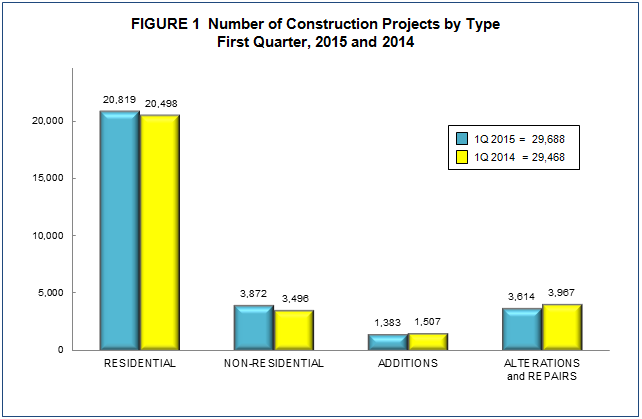
- The top five regions in terms of the number of construction projects accounted for 61.8 percent of the total. Region IVA (CALABARZON) led the regions with 6,874 projects representing 23.2 percent of the total, followed by Region 3 (Central Luzon) with 3,538 projects (11.9%). Region VII (Central Visayas), having the largest count in the Visayas area, ranked third with 2,897 projects (9.8%). National Capital Region (NCR) with 2,780 projects (9.4%) and Region I (Ilocos Region) with 2,256 projects (7.6%) placed fourth and fifth, respectively. Figure 2 shows the distribution of construction projects by region.
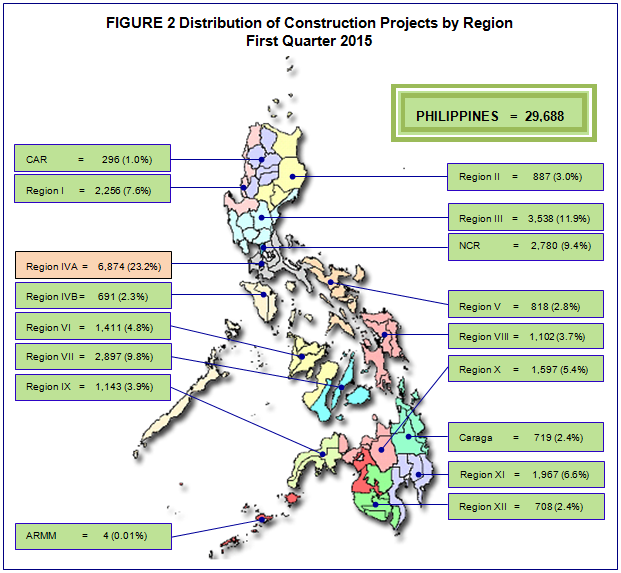
- At the provincial level, the top ten provinces comprised 43.5 percent of the total. Cavite topped the list of provinces with 2,641 construction projects or 9.0 percent of the total, followed by Bulacan and Batangas with respective shares of 1,527 projects (5.2%) and 1,345 projects (4.6%). Completing the top ten provinces with the most number of construction projects were as follows:
- Laguna with 1,247 projects (4.3%)
- Rizal with 1,139 projects (3.9%)
- Bohol with 1,096 projects (3.7%)
- Davao Del Sur with 1,022 projects (3.5%)
- Cebu with 968 projects (3.3%)
- Pangasinan with 884 projects (3.0%)
- Leyte with 870 projects (3.0%)
- Among the top ten provinces, Leyte, the typhoon-stricken province, recorded the highest increase (698.2%) in the number of construction projects from the 109 projects recorded during the same period in 2014. This was mainly attributed to the five-digit growth in the construction of apartment/accessoria-type dwellings (14,733.3%) and three-digit growth in single-type houses (330.8%) in the province.
Total value of construction amounts to PHP79.2 billion
- Total value of construction projects reached PHP79.2 billion during the first quarter of 2015, representing an increase of 29.5 percent from previous year’s construction value of PHP61.1 billion.
- Value of residential construction, accounting for more than half (50.5%) of the total value of construction, grew 37.4 percent estimated at PHP40.0 billion from PHP29.1 billion recorded during the first quarter of 2014.
- Value of non-residential construction amounting to PHP30.9 billion went up 14.5 percent from PHP27.0 billion posted during the same quarter of 2014.
- Similarly, construction value of additions to existing structures estimated at PHP1.9 billion surged 77.8 percent compared with PHP1.1 billion during the first quarter of 2014. Alterations and repairs of existing structures amounting to PHP6.3 billion rose 60.3 percent from PHP4.0 billion registered during the same period of 2014. Figure 3 compares the value of construction projects by type for the first quarters of 2015 and 2014.
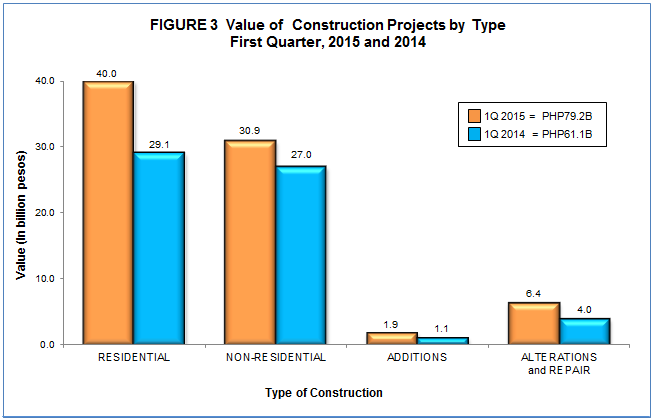
- Across the country, the top three regions in terms of the value construction were all located in the Luzon area with a combined value amounting to PHP53.9 billion or 68.1 percent of the total. NCR, ranking fourth in the number of construction projects, remained highest in terms of the value of construction with PHP37.3 billion or 47.2 percent of the total. This was followed by adjacent regions CALABARZON and Central Luzon with construction value of PHP11.1 billion (14.0%) and PHP5.6 billion (7.1%), respectively. Central Visayas and Western Visayas with respective shares of PHP5.6 billion (7.0%) and PHP3.5 billion (4.5%) placed fourth and fifth.
Average cost of residential-type building rises 22.1 percent
- Total value of residential construction estimated at PHP40.0 billion and total floor area of 3.5 million square meters resulted to an average cost of PHP11,289 per square meter. This figure was 22.1 percent higher than the average cost of PHP9,249 per square meter registered during the same period of 2014.
- Among residential constructions, single-type houses recorded the most number with 17,674 projects accounting for 84.9 percent of the total. Total value of construction for this type amounted to PHP15.3 billion covering a total floor area of 1.8 million square meters, resulting to an average cost of PHP8,640 per square meter.
- Apartment/accessoria-type units ranked a far second with 2,352 projects or 11.3 percent of the total residential construction. This type of construction had a construction value of PHP4.9 billion with total floor area of 663.1 thousand square meters or an average cost of PHP7,363 per square meter.
- Duplex/quadruplex-type dwellings followed with 749 projects or 3.6 percent of the total residential construction. Total value of construction for this type amounted to PHP636.4 million with a total floor area of 75.7 thousand square meters or an average cost of PHP8,403 per square meter.
- Residential condominiums numbering to only 22 projects with construction value of PHP19.1 billion comprised 47.8 percent of the total residential construction. Total floor area for this type of construction was recorded at 1.0 million square meters. This translates to an average cost of PHP18,628 per square meter. Figure 4 displays the percentage distribution of the number and value of residential constructions by type for the first quarter of 2015.
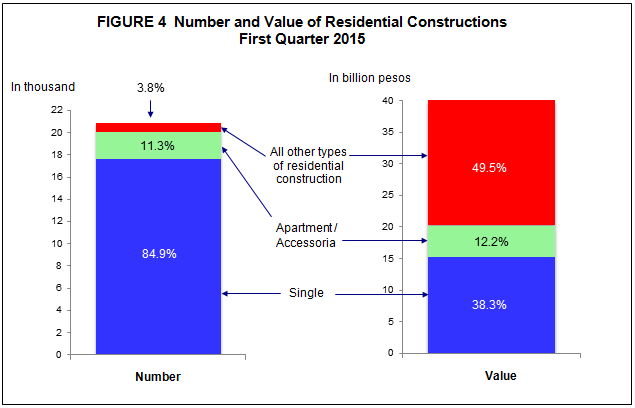
Average cost of non-residential construction is PHP10,632 per square meter
- Value of non-residential constructions for the first quarter of 2015 summed-up to PHP30.9 billion with a total floor area of 2.9 million square meters. This translates to an average cost of PHP10,632 per square meter, an increase of 17.0 percent compared with previous year’s average cost of PHP9,090 per square meter.
- Commercial-type buildings dominated all other types of non-residential constructions with 2,343 projects representing 60.5 percent of the total. Construction value for this type amounted to PHP18.9 billion with a total floor area of 1.8 million square meters or an average cost of PHP10,400 per square meter.
- Institutional buildings distantly followed with 798 projects (20.6%), construction value of PHP4.7 billion and total floor area of 374.1 thousand square meters, equivalent to an average cost of PHP12,488 per square meter.
- Industrial buildings ranked third with 450 projects (11.6%), construction value of PHP6.0 billion and total floor area of 541.8 thousand square meters, translating to an average cost of PHP11,082 per square meter.
- Agricultural buildings comprised only 194 projects or 5.0 percent of the total non-residential construction. Construction value for this type was estimated at PHP592.4 million with total floor area of 180.0 thousand square meters or an average cost of PHP3,290 per square meter. Figure 5 shows the number and value of non-residential constructions by type for the first quarter of 2015.
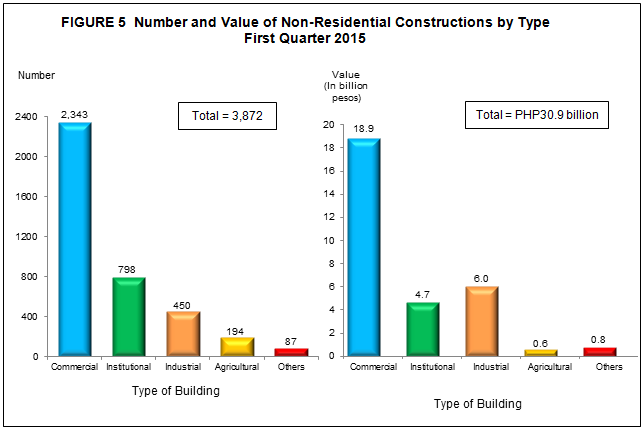
TECHNICAL NOTES
CONSTRUCTION STATISTICS FROM APPROVED BUILDING PERMITS
Introduction
This Special Release presents the preliminary data on construction statistics from approved building permits for the first quarter of 2015, generated 60 calendar days after the reference quarter.
For this publication, data for the provinces of Lanao Del Sur, Sulu, and Tawi-Tawi are not included in the tabulation as these provinces did not submit any building permit document and/or certification of no construction before the generation of preliminary tables. However, if any, these are to be included in the annual tabulation.
Data are presented at the provincial level by type of construction in Tables 1 to 5.
Scope and Coverage
Construction statistics from approved building permits relate to administrative-based data on new constructions and additions, alterations and repairs of existing residential and non-residential buildings and other structures proposed to be constructed in all cities and municipalities of the country in a specific period.
Source of Information
Construction statistics are compiled by the Philippine Statistics Authority from the copies of original application forms of approved building permits as well as from the demolition permits collected every month by PSA field personnel from the Offices of Local Building Officials (LBOs) nationwide.
Limitations
- Data on building constructions refer to those approved applications during the reference period and not to construction work completed during the reference period.
- The completeness of the number of building permits collected relies on the approval of applications filed with the LBOs. Hence, private building constructions without approved building permits are excluded in the tabulation of data.
Geographic Classification
Building constructions are classified and presented by geographic area using the Philippine Standard Geographic Classification (PSGC). The geographic codes are in accordance with NSCB Resolution No. 3, Series of 2005 that approved the PSGC.
Industry Classification
Construction statistics utilizes the amended 2009 Philippine Standard Industrial Classification to classify the main activity through the use or type of occupancy of the building.
Definition of Terms (Adopted from the Revised and Updated IRR of the National Building Code)
Building Permit is a written authorization granted by the LBO to an applicant allowing him to proceed with the construction of a specific project after plans, specifications and other pertinent documents have been found to be in conformity with the National Building Code (PD 1096).
Building is any independent, free-standing structure comprised of one or more rooms or other spaces, covered by a roof and enclosed with external walls or dividing walls, which extend from the foundation to the roof.
Construction refers to all on-site work done from site preparation, excavation, foundation, assembly of all the components and installation of utilities, machineries and equipment of buildings/structures.
Residential Building is a building for which its major parts or more than half of its gross floor area is built for dwelling purposes. This type of building can be of the single type, duplex, quadruplex, apartment and/or accessoria, and residential condominium.
Single House is a complete structure intended for a single family or household, i.e. bungalow, 2-storey house, nipa hut.
Duplex is a structure intended for two households, with complete living facilities for each; it is a single structure divided into two dwelling units by a wall extending from the floor to the ceiling.
Apartment is a structure, usually of two storeys, made up of independent living quarters, with independent entrances from internal walls and courts.
Accesoria is a one or two-floor structure divided into several dwelling units, each dwelling unit having its own separate entrance from the outside.
Residential Condominium is a structure, usually of several storeys, consisting of multiple dwelling units.
Other residential construction consists of school or company staff houses, living quarters for drivers and maids and guardhouses.
Non-Residential Building includes commercial, industrial, agricultural and institutional buildings.
Commercial Building includes office buildings and all buildings which are intended for use primarily in wholesale, retail and service trades; i.e. stores, hotels, restaurants, banks, disco houses, etc.
Industrial Buildings are buildings which are used to house the production, assembly and warehousing activities of industrial establishments; i.e. factories, plants, mills, repair shops, machine shops, printing press, storage plant, electric generating plants.
Institutional Buildings are buildings which are primarily engaged in providing educational instructions and hospital/health care; ports, airports and other government buildings; i.e. school, museums, libraries, sanitaria, churches, hospitals.
Agricultural Buildings are buildings which are used to house livestock, plants and agricultural products such as barn, poultry house, piggeries, stables, greenhouses and grain mill.
Other Non-Building Constructions include cemetery structures, street furniture, waiting sheds, communication towers, etc.
Addition refers to any new construction which increases the height or area of an existing building/structure.
Alteration refers to construction in a structure involving changes in the materials used, partitioning, location/size of openings, structural parts, existing utilities and equipment but does not increase the overall area thereof.
Repair refers to remedial work done on any damaged or deteriorated portion/s of a structure to restore its original condition.
Demolitions refer to the systematic dismantling or destruction of a building/structure or in part.
Street Furniture are street structures consisting of monuments, waiting sheds, benches, plant boxes, lampposts, electric poles and telephone poles.
Floor Area of Building refers to the sum of the area of each floor of the building measured to the outer surface of the outer walls including the area of lobbies, cellars, elevator shafts and all communal spaces in multi-dwellings. Areas of balconies are excluded.
Total Value of Construction refers to the sum of the cost of building, electrical, mechanical, plumbing, and others. The value is derived from the approved building permit and represents the estimated value of the building or structure when completed.
